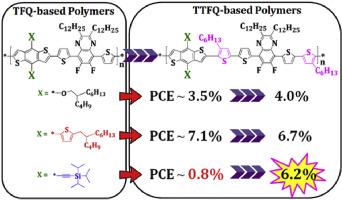Polymer ( IF 4.1 ) Pub Date : 2020-03-21 , DOI: 10.1016/j.polymer.2020.122408 Vellaiappillai Tamilavan , Soyeong Jang , Jihoon Lee , Rajalingam Agneeswari , Ji Hyeon Kwon , Joo Hyun Kim , Youngeup Jin , Sung Heum Park

|
A series of novel alternating polymers, namely P(BDTO-TTFQ), P(BDTT-TTFQ), and P(BDTSi-TTFQ), incorporating electron-rich benzo [1,2-b:4,5-bʹ]dithiophene (BDT) derivatives, namely 4,8-bis(2-butyloctyloxy)benzo [1,2-b:4,5-bʹ]dithiophene (BDTO), 4,8-bis(5-(2-butyloctyl)thiophen-2-yl)benzo [1,2-b:4,5-bʹ]dithiophene (BDTT), and 4,8-bis(triisopropylsilylethynyl)-benzo [1,2-b:4,5-ʹ]dithiophene (BDTSi), as well as electron-deficient 5,8-bis(5-(4-hexylthiophen-2-yl)thiophen-2-yl)-2,3-didodecyl-6,7-difluoroquinoxaline (TTFQ) units were prepared. The photo-physical, electrochemical, crystallinity, curvature, charge transport, and photovoltaic properties of the TTFQ-based polymers were investigated thoroughly and compared briefly to those of structurally similar 2,3-didodecyl-6,7-difluoro-5,8-di(thiophen-2-yl)quinoxaline (TFQ)-based polymers, namely P(BDTO-TFQ), P(BDTT-TFQ), and P(BDTSi-TFQ), containing BDTO, BDTT, and BDTSi. This study confirmed that the incorporation of additional π˗bridges (3-hxeylthiophene) between the BDT and TFQ units of P(BDTO-TFQ), P(BDTT-TFQ), and P(BDTSi-TFQ) do not significantly alter the properties of the polymers P(BDTO-TFQ) and P(BDTT-TFQ), but do significantly alter the properties of P(BDTSi-TFQ). Consequently, the polymers P(BDTO-TTFQ) and P(BDTT-TTFQ) exhibit comparable power conversion efficiencies (PCEs, 3.99% and 6.69%, respectively) to those of P(BDTO-TFQ) and P(BDTT-TFQ) (3.49% and 7.06%, respectively), but P(BDTSi-TTFQ) exhibits a significantly improved PCE of 6.21% compared to that of P(BDTSi-TFQ) (0.75%).
中文翻译:

benzodithiophene-的增强光伏性能ALT双(噻吩-2-基)喹喔啉的聚合物通过π-桥梁工程非富勒烯有机太阳能电池
一系列新颖的交替聚合物,即P(BDTO-TTFQ),P(BDTT-TTFQ)和P(BDTSi-TTFQ),并结合了富电子的苯并[1,2-b:4,5-bʹ]二噻吩(BDT)衍生物,即4,8-双(2-丁基辛基氧基)苯并[1,2-b:4,5-bʹ]二噻吩(BDTO),4,8-双(5-(2-丁基辛基)噻吩-2-基)苯并[1,2-b:4,5-bʹ]二噻吩(BDTT)和4,8-双(三异丙基甲硅烷基乙炔基)-苯并[1,2-b:4,5-ʹ]二噻吩(BDTSi),以及缺电子的5,8-双(5-(4-己基噻吩-2-基)噻吩-2-基制备)-2,3-二癸基-6,7-二氟喹喔啉(TTFQ)单元。彻底研究了基于TTFQ的聚合物的光物理,电化学,结晶度,曲率,电荷传输和光伏性能,并将其与结构相似的2,3-二十二烷基-6,7-二氟-5,8-基于二(噻吩-2-基)喹喔啉(TFQ)的聚合物,即P(BDTO-TFQ),P(BDTT-TFQ)和P(BDTSi-TFQ),其中包含BDTO,BDTT和BDTSi。这项研究证实,在P(BDTO-TFQ),P(BDTT-TFQ)和P(BDTSi-TFQ)的BDT和TFQ单元之间掺入其他π桥(3-己基噻吩)不会显着改变性能聚合物P(BDTO-TFQ)和P(BDTT-TFQ)的合成,但确实会显着改变P(BDTSi-TFQ)的性质。因此,聚合物P(BDTO-TTFQ)和P(BDTT-TTFQ)具有与P(BDTO-TFQ)和P(BDTT-TFQ)(3.49%和7.06 )相当的功率转换效率(分别为3.99%和6.69%) %,分别地),但是P(BDTSi-TTFQ)表现出6.21%一显著提高PCE相比P(BDTSi-TFQ)(0.75%)的。











































 京公网安备 11010802027423号
京公网安备 11010802027423号